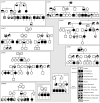Whole-genome sequencing in multiplex families with psychoses reveals mutations in the SHANK2 and SMARCA1 genes segregating with illness
- PMID: 27001614
- PMCID: PMC5033653
- DOI: 10.1038/mp.2016.24
Whole-genome sequencing in multiplex families with psychoses reveals mutations in the SHANK2 and SMARCA1 genes segregating with illness
Abstract
A current focus in psychiatric genetics is detection of multiple common risk alleles through very large genome-wide association study analyses. Yet families do exist, albeit rare, that have multiple affected members who are presumed to have a similar inherited cause to their illnesses. We hypothesized that within some of these families there may be rare highly penetrant mutations that segregate with illness. In this exploratory study, the genomes of 90 individuals across nine families were sequenced. Each family included a minimum of three available relatives affected with a psychotic illness and three available unaffected relatives. Twenty-six variants were identified that are private to a family, alter protein sequence, and are transmitted to all sequenced affected individuals within the family. In one family, seven siblings with schizophrenia spectrum disorders each carry a novel private missense variant within the SHANK2 gene. This variant lies within the consensus SH3 protein-binding motif by which SHANK2 may interact with post-synaptic glutamate receptors. In another family, four affected siblings and their unaffected mother each carry a novel private missense variant in the SMARCA1 gene on the X chromosome. Both variants represent candidates that may be causal for psychotic disorders when considered in the context of their transmission pattern and known gene and disease biology.
Figures

References
Publication types
MeSH terms
Substances
Grants and funding
LinkOut - more resources
Full Text Sources
Other Literature Sources
Medical

